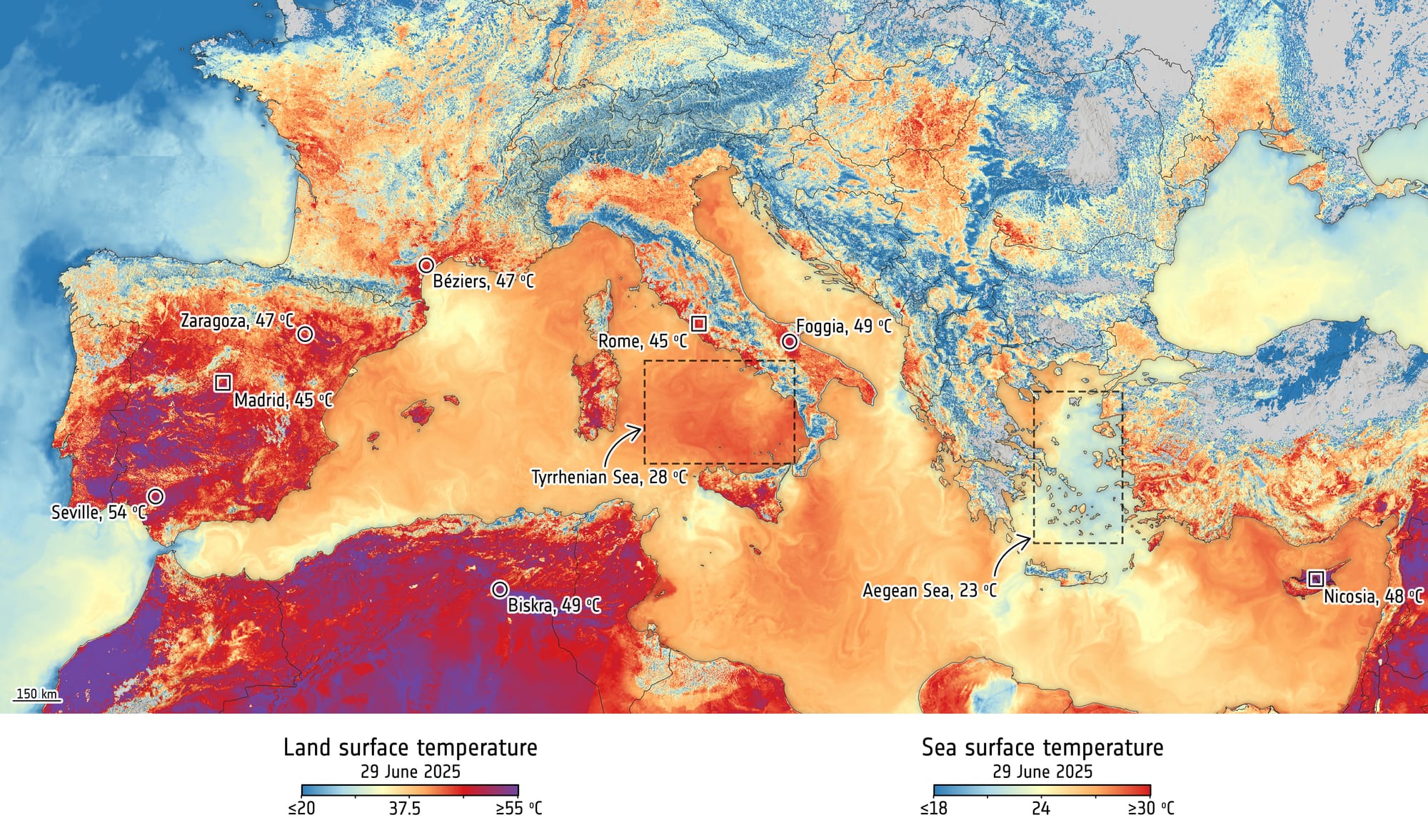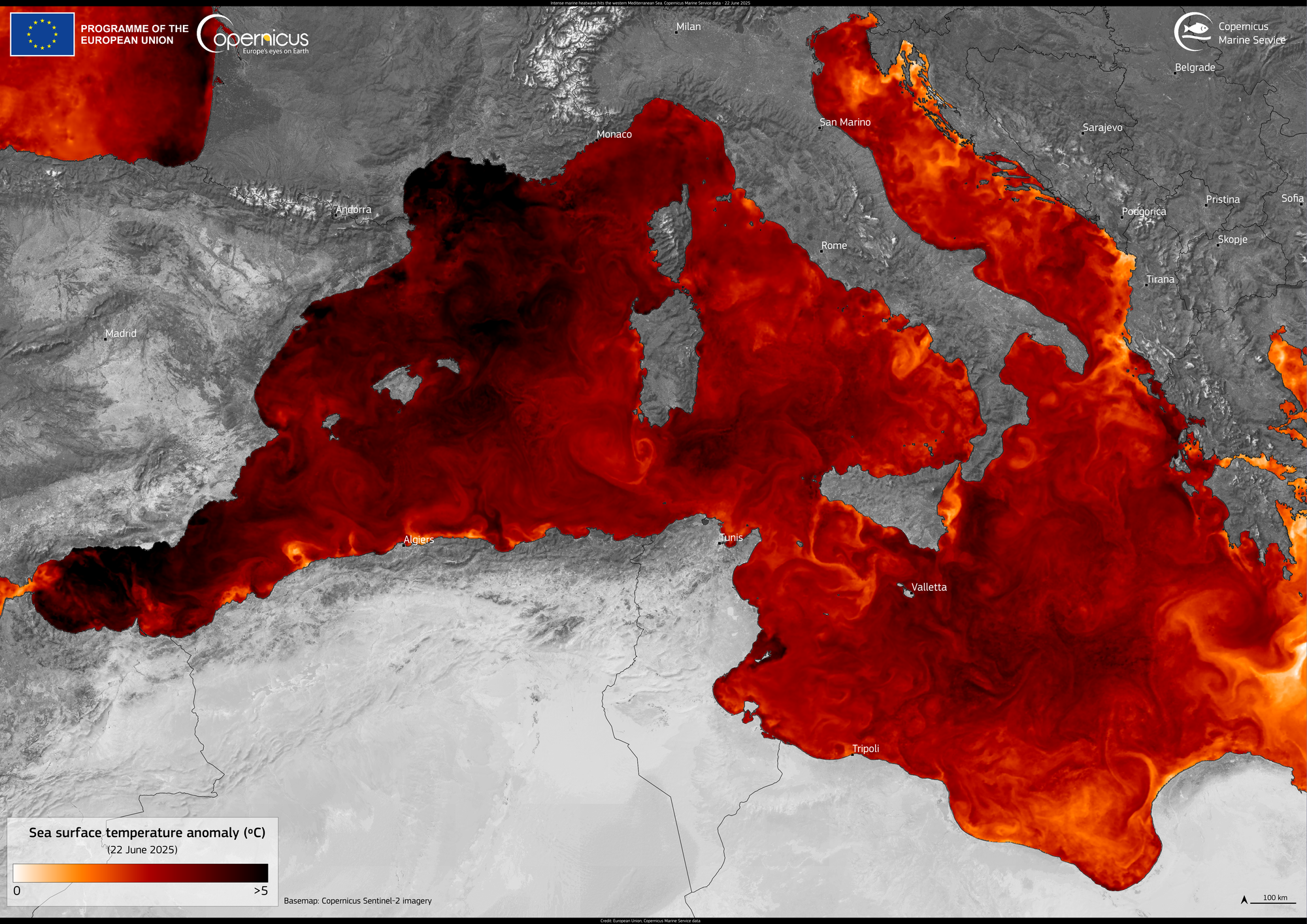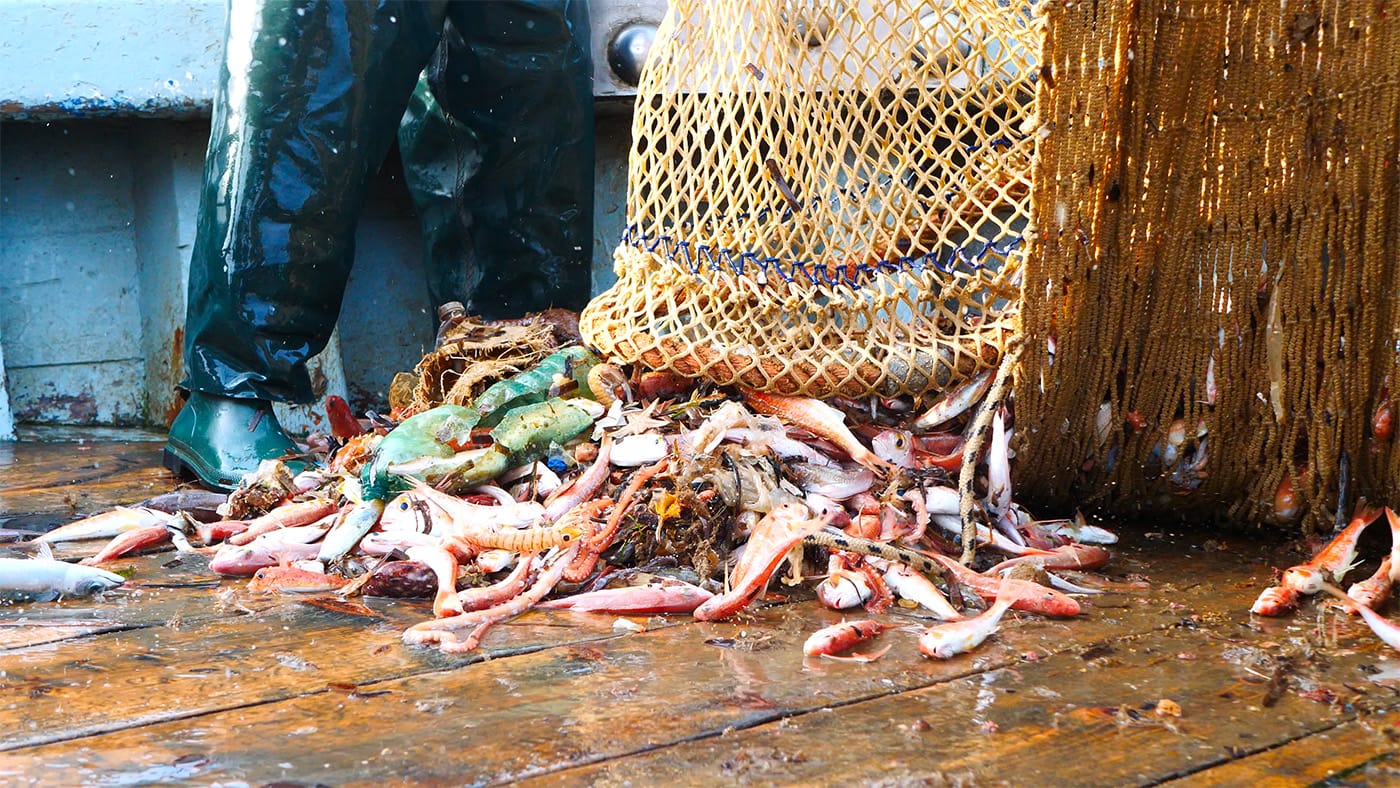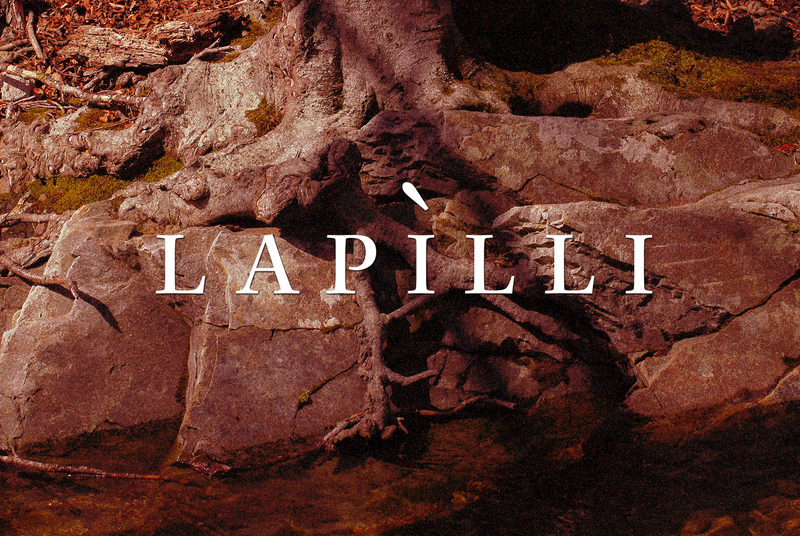In this edition of Lapilli, we look at a summer that’s only just begun, yet is already burning. Between the second half of June and early July, a powerful heatwave swept across southern Europe, from the Balkans to Portugal, with temperatures nearing 40 degrees Celsius (104 degrees Fahrenheit) — levels more typical of late July or August.
And it’s not just the air that’s heating up. The Mediterranean Sea is also under stress. Surface water temperature is already above average, especially in parts of the Tyrrhenian and the Gulf of Lion. Next, we dive underwater to find what’s happening to local hake populations that are at risk of biological collapse, partly due to their demand as an ingredient in mixed fried fish platters.
We then resurface in France, where scientists are studying a forest on the Spanish border to understand how nature is adapting to a shifting climate. In between, we make a stop in Nice, where the United Nations Ocean Conference took place in early June, and then in Rome, where — finally — the city has started working with researchers to monitor the impacts of extreme heat on its neighborhoods. And, as always, we continue connecting the dots to uncover how the Mediterranean is changing — and what we can do about it.
Enjoy your reading!

A scorching Mediterranean. From Spain to the Balkans, passing through Portugal, Italy and Greece, the first heatwaves of the summer set record temperatures in the second half of June and the first week of July. In Andalusia, in southern Spain, temperatures in El Granado reached 46 degrees Celsius (114.8 degrees Fahrenheit) — a record high for June. In several places across southern Europe and the Balkans, temperatures exceeded 40 degrees Celsius (104 degrees Fahrenheit) — levels more in line with the end of July. In Serbia, June 25 was the hottest day ever recorded. Meanwhile, in Sarajevo, Bosnia and Herzegovina, temperatures reached 38.8 degrees Celsius (101.8 degrees Fahrenheit), a new record for the city (BBC). In Paris, the top of Eiffel Tower was closed due to the heatwave. The first wildfires have broken out south of Athens and Crete, in Greece, as well as in Türkiye, where more than 50,000 people have been evacuated. In Italy, the extreme heat prompted the Ministry of Health to declare an alert in 21 cities.
According to the United Nations’ Intergovernmental Panel on Climate Change, heatwaves are becoming more frequent, intense and longer due to human-induced climate change (BBC; BBC; Reuters; The New York Times).

It’s not just the air and the earth. The sea is also affected by the anomalous warming. On June 22, Europe's Earth Observation program, Copernicus, recorded a significant marine heatwave in the western Mediterranean, particularly between the Gulf of Lion and the Tyrrhenian Sea, with surface temperatures more than 5 degrees Celsius (9 degrees Fahrenheit) higher than the seasonal average.
The following day, the Mediterranean Environmental Studies Center recorded an average temperature of 25.1 degrees Celsius (77.2 degrees Fahrenheit) in the Mediterranean basin. Such a high value risks amplifying extreme weather phenomena and compromising the balance of marine ecosystems (Costa Blanca Daily). A few days later, on June 29, Copernicus again recorded a sea temperature of 26 degrees Celsius (78.8 degrees Fahrenheit), the highest temperature ever recorded in June (Le Monde).

This marine heatwave must be placed within the historical context: The average temperature of the Mediterranean Sea has been continuously increasing. From the 1980s to today, the average annual sea temperature has increased by nearly 2 degrees Celsius (3.6 degrees Fahrenheit). An increasingly warm sea — as we have stated in previous newsletters — stores more and more energy, which is then released in the form of increased storms and intense meteorological phenomena (La Stampa).
Marine heatwaves are not just a Mediterranean concern. The New York Times visualized the percentage of the oceans affected by heatwaves each month from 2000 to today, highlighting the increasing trend in the frequency and extent of these phenomena.
The causes of the Iberian blackout. It turns out renewable energy had nothing to do with the massive blackout that hit Spain and Portugal at the end of April. In the immediate aftermath, some were quick to blame solar and wind energies — sectors Spain has invested heavily in recent years — arguing that they are less reliable. But now, two official reports — one from Spain’s grid operator Red Eléctrica and another from the central government — tell a different story. The failure, they say, was caused by a shortfall in conventional power and the inability of gas and nuclear plants to respond fast enough. That gap triggered a chain reaction that led to the disconnection of multiple power stations (Yale 360; Newtral).
Dispatches from Nice. As mentioned in the last issue of Lapilli, part of the Magma editorial team was in Nice for the third UN Ocean Conference (UNOC). Davide Mancini attended as a Pulitzer Center Ocean Reporting Fellow, and Guia Baggi was there as a mentor for Mediterranean journalists selected by the Earth Journalism Network (EJN).
Through the voices and stories of some of these EJN fellows, we revisit some key issues, particularly those with direct relevance to the Mediterranean.
During the conference, FAO shared its latest report update on the state of global fish stocks. Once again, the numbers are worrying: in the region, which includes the Mediterranean and Black Sea, 65 percent of fish stocks are overexploited (Esg Mena).
On this topic, Libyan journalist Islam Al-Atrash published two reports. The first focused on environmental degradation along Libya’s coastline and the country’s limited presence at the Nice conference (Libya Al-Ahrar). In the second, Al-Atrash highlighted the urgent need for cooperation between the northern and southern shores of the Mediterranean to address the steep decline in fish stocks (Deutsche Welle Arabic).
Climate change also plays a role in this context, as highlighted by Spanish journalist Mario Viciosa in his multimedia package dedicated to the Nice conference (Newtral). “We have entered the energy equivalent of thousands of atomic bombs [in the oceans] and now we see it in the extreme [events] of recent years,” says Dominic Roye, physicist and climatologist of the Biological Mission in Galicia of the Spanish National Research Council.
Corals are among the most affected by these changes. In an article for the Egyptian magazine Al-Ahram, journalist Hadeer Elhadary explores the situation in greater depth, particularly in the Red Sea. Coral reefs serve as nurseries for commercially important fish species and natural barriers for coastal environments against extreme events and rising sea levels. However, repeated bleaching events are threatening the survival of these ecosystems. In Nice, several countries committed to allocating $25 million to the Global Coral Reef Fund for the protection of these vulnerable ecosystems.
Finally, in an article for Domani, Italian journalist Federica Rossi reviewed the commitments made during the conference, especially about the goal set in 2022 in Montreal at the UN Biodiversity Conference to protect 30 percent of marine and terrestrial ecosystems by 2030. The piece hones in on Italy, where the Institute for Environmental Protection and Research (ISPRA) claims that marine protected areas cover 11.62 percent of national waters. However, Greenpeace puts the real figure much lower, excluding the Pelagos Sanctuary for Mediterranean marine mammals. The sanctuary spans the waters of not just Italy but France and Monaco and is not regulated like more stringent MPAs. The good news is that during the conference, all three countries signed a new agreement to reinforce the sanctuary’s protection.
However, not everyone left Nice feeling optimistic. Several non-governmental organizations (NGOs) pointed out that the conference fell short on many of the priorities highlighted by the UN’s Secretary General Antonio Guterres in his speech on the second day of UNOC, especially the need to reduce reliance on fossil fuels (Dialogue Earth).
We’ll leave it here for now. But we’ll return to some of these conversations over the summer — starting with the next issue of Lapilli+, where we’ll dive into the state of small-scale fishing in the Mediterranean.

Illegal hake fishing (for fried fish). An investigation into the Italian ports of Tuscany, Lazio, Campania and Sicily revealed that undersized hake — measuring between 7 and 20 centimeters (2.7 and 7.8 inches) — are being caught and sold illegally, despite laws prohibiting their commercialization. The species is now in serious biological decline: Hake stocks in the western Mediterranean have fallen to just 9 and 10 percent of their sustainable level. In other words, there should be about ten times more hake to allow fishing the species without risking its collapse.
Two factors are driving this situation. On one hand, there is widespread overexploitation of fish resources throughout the Mediterranean (Corriere della Sera). On the other hand, the indiscriminate use of trawling damages the seabed and disrupts nursery grounds for juvenile fish, preventing the species from reproducing. Despite bans, fishing and selling undersized hake remains a common and easily accessible practice. These small hakes frequently end up on the restaurant tables and at local festivals, where they are a highly prized ingredient in the famous “frittura di paranza” dish, or simply fried small fish.
Demand is so high that a black market has emerged. Blue boxes of illegal hake are hidden and sold between docks and market stalls, often with the complicity of fishermen and retailers. Many fishing boats use non-compliant nets with meshes that are too small or modify their equipment at sea to retain the smaller fish.
Solutions do exist, such as using selective nets and temporarily closing hakes nursery areas. But without effective enforcement and greater consumer awareness, the entire species is at risk of disappearing.
The investigation, supported by Journalismfund and the Earth Journalism Network, has been published in several media: in English and in Italian at One Earth and in Spanish (with an interactive version with detailed infographics) at El Confidential.

Cool vacations. Climate change has begun to impact travel habits. Recent surveys show that over 80 percent of Europeans have revised their summer vacation plans. Increasingly, Europeans are avoiding traditionally hot destinations in July and August, opting to visit them during cooler months and heading to more temperate destinations during the summer instead. This trend raises questions about the future viability of southern Europe as a summer destination, especially if temperatures continue to rise.
In response, Mediterranean resorts are adapting by promoting the low season, expanding their offerings with evening and indoor activities, and investing in new attractions to retain tourists during the cooler months.
At the same time, alternative destinations like Sweden, Norway and Iceland are gaining popularity. U.K. “staycations” — vacations spent at home or nearby — are also becoming more popular, thanks in part to a milder domestic climate.
For now, the classic summer seaside vacation remains the dominant choice, largely due to school holidays limiting family flexibility. However, experts warn that if heatwaves and wildfires continue at the intensity of recent years, the way we think about summer vacations could profoundly change (BBC).

Rome implements climate monitoring. Increasingly, extreme weather is prompting many cities to adopt tools to manage rising temperatures and heatwaves. Recently, Rome, in collaboration with the Euro-Mediterranean Center on Climate Change (CMCC), unveiled the capital’s first climate monitoring report. The aim is to combine the most updated data with concrete actions to be taken during critical periods.
Last year — 2024 — has already been confirmed as the hottest on record in Rome since 1991. According to CMCC estimates, the frequency of summer heatwaves in the city could increase by 186 percent in the future. This initiative marks an important first step towards more resilient urban planning in a Mediterranean region increasingly vulnerable to extreme weather events.

A forest under "special surveillance". A few miles from the Mediterranean Sea, in the French Pyrenees, lies a pristine forest that has become a living laboratory. The Massane Forest, spanning 336 hectares in the Albera Massif, has been untouched by human intervention since 1886. This makes it a rare example of an ancient forest that has evolved naturally. Its value is so great that it has been a national nature reserve since 1973 and a UNESCO World Heritage site since 2021.
Over 12,000 species inhabit the forest, including 2,000 insects and 931 fungi species, some of which can’t be found anywhere else. This remarkable biodiversity, especially for such a small area, has been studied in great detail for more than 50 years. More than 70,000 beech trees are individually monitored for height, growth, diseases and adaptations — each tree telling a story in progress. The reserve has thus become an open-air scientific laboratory where the long-term effects of climate change are carefully observed.
Since 2019, scientists have recorded an acceleration of climate change impacts in the forest, including reduced rainfall and steadily rising summer temperatures, with peaks above 40 degrees Celsius (104 degrees Fahrenheit). One key phenomenon under study is “cavitation”, where trees, facing water scarcity, interrupt water flow in certain parts of its limbs to protect the main trunk. This process is often compared to a stroke in plants. If the water flow inside the trunk remains blocked for too long, it can cause the tree’s death within a few years.
The site’s autonomous evolution makes it especially valuable, allowing scientists to study natural adaptation and regeneration strategies. In an era marked by climate crises and increasingly severe wildfires, these insights offer important guidance on ecosystem protection. The new European Nature Restoration Law, approved in 2024, aligns with this approach, promoting nature’s ability to recover on its own whenever possible (Sonda Internacional).


GUGLIELMO MATTIOLI
As a multimedia producer, he has contributed to innovative projects using virtual reality, photogrammetry, and live video for The New York Times. In a past life, he was an architect and an urban planner, and many of the stories he produces today are about the built environment. He has worked with publications such as The New York Times, The Guardian, and National Geographic. Born and raised in Genoa, Italy, he has been living and working in New York City for more than 10 years.That's it for this month. Thank you for reading this far. See you in August or earlier with Lapilli+.
If this newsletter was forwarded to you, you can subscribe here to continue receiving it. Lapilli is free and always will be, but in case you would like to buy us a coffee or make a small donation, you can do so here. Thank you!
Lapilli is the newsletter that collects monthly news and insights on the environment and the Mediterranean, seen in the media and selected by Magma.

